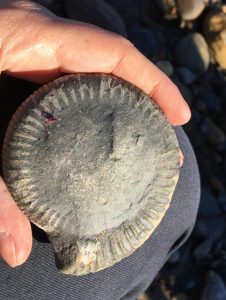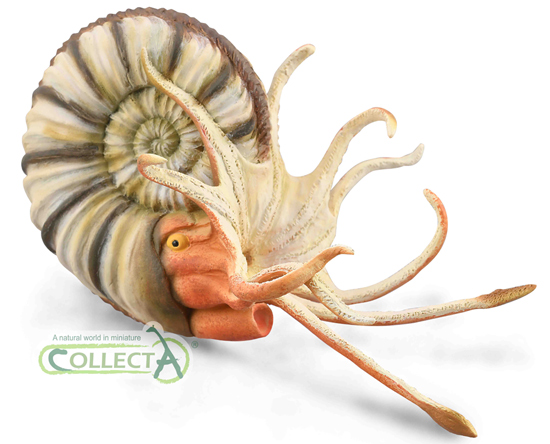French and U.S. Scientists Help to Unlock the Mystery of an Ammonite’s Diet
Ammonites are an extinct group of cephalopod molluscs that lived in spiral shaped, chambered, coiled shells. The fossilised remains of these marine creatures are abundant and can be found in Mesozoic sediments throughout the world. The fossils are extremely important and many different genera are used to help confirm the relative ages of rock strata, this process is called biostratigraphy.
Particular zones in a series of layers of sedimentary rock are classified by the distinct fossils that each zone contains and due to the abundance of ammonite fossils and the readiness of this particular group of creatures to evolve into myriad forms, ammonites make ideal fossils for biostratigraphy.
Ammonite Fossils
A Wonderful Early Jurassic Ammonite Fossil
Picture credit: Everything Dinosaur
A beautiful ammonite (Dactylioceras?) preserved as a pyretic specimen from the English coast.
Although very common as fossils, there is still a great deal that scientists have yet to learn about these ancient relatives of squid and cuttlefish. For example, without any soft parts of the animal fossilised, it is very difficult to determine what these creatures fed on, where in the food chain did they fit?
They did form an important part of the diet of many of the larger animals that shared the ammonite’s marine environment, scientists believe that many types of marine reptiles, such as mosasaurs and ichthyosaurs fed on ammonites. With the extinction of the ammonites 65 million years ago, did this also mean the end of the mosasaurs that relied on them as prey?
Such is the connection between marine reptiles and ammonites that Safari, the American based figure manufacturer, recently introduced a new model of an ichthyosaur that had an ammonite in its mouth.
The Safari Ltd Carnegie Collection Ichthyosaurus

Picture credit: Everything Dinosaur
Ichthyosaurs Feeding on Ammonites
Just how many ichthyosaurs fed on ammonites is a bit of a mute point, as many genera had toothless beaks, perhaps better suited to tackling soft-bodied cephalopods rather than hard-shelled ones.
To view the Safari Ltd prehistoric animal model range and dinosaur toys: Safari Ltd. Wild Safari Prehistoric World Models and Figures.
Last Supper of an Ammonite
A new study by a joint team of French and U.S. based scientists, published in the scientific journal “Science” provides fresh evidence on the diet of one particular ammonite. It seems that the larval stage of snails and tiny crustaceans were on this particular cephalopods menu.
Lead author of this new paper, Isabelle Kruta of the Musee National d’Histoire Naturelle (Paris) commented on using very powerful X-ray beams to see inside the fossilised remains of a Baculites ammonite. It revealed the last prey consumed was a small larval snail and three tiny crustaceans.
The French and American researchers have been able to reveal the lives and deaths of a number of different ammonite specimens in amazing detail. Using a technique called synchrotron X-ray microtomography, an advanced form of CT scanning, three-dimensional images of several ammonite fossils were created. These images have provided new information about ammonites, including providing some data on the types of prey that certain genera may have consumed.
Ammonite Jaws and the Radula
The researchers determined ammonites possessed jaws and a radula, which is like a tongue covered with teeth. Garden snails have radulas, their affect can be seen if you leave a lettuce leaf out in the garden on a wet summers evening. In this study different types of ammonite teeth were identified, from slender ones to sabre-like or even ones shaped like the teeth on a comb.
Each colour in the computer images produced shown above shows a different type of tooth on the radula-like structure of the Late Cretaceous ammonite Baculites. This image was created by synchrotron radiation microtomographic slices.
Commenting on the images, lead author, Kruta explained:
“Ammonites used their radula to trap the food in the mouth and convey it through the oesophagus.”
The oesophagus describes the part of the alimentary canal from the mouth to the stomach.
This feeding system, along with the fossilised last supper remains, suggests that ammonites were adapted for eating small prey, such as tiny crustaceans and plankton, floating in the water.
This research could have a bearing on theories related to the extinction of marine organisms at the end of the Cretaceous Period. An extra-terrestrial impact could have killed many of the small nektonic or planktonic organisms that ammonites relied on for prey. This in turn, would have led to the collapse of much of the marine environment’s food chain.
Ammonite Diet
In a separate paper also published in journal Science, palaeontologist Kazushige Tanabe of The University of Tokyo postulates that newly hatched ammonites were particularly dependent upon such small prey items.
He stated:
“The abrupt decline of phytoplankton at the end of the Cretaceous led to the collapse of marine food webs and would have greatly affected the survival of newly hatched ammonites.”
When asked why so little is known about ammonites, despite the abundant fossil record, Tanabe said:
“Ammonites are some of the most famous invertebrate animals in Earth’s history. Yet as biological entities they are poorly understood, largely owing to the absence of a direct living counterpart.”
The new high-resolution, three-dimensional images may help to solve some of the ammonite mysteries. They also help to explain why one of the world’s most successful animals, in terms of abundance and species longevity, suddenly bit the dust along with the dinosaurs, marine reptiles and pterosaurs.
Whilst discussing the affect on food chains of the loss of the Ammonites, Kruta stated:
“Known predators of ammonites were, for example, mosasaurs and plesiosaurs.”
It was speculated that the disruption of the food chains would have had a significant effect on apex predators such as the marine reptiles.
Kruta and her team hope additional research can help to further unravel what happened to ammonites and other prehistoric animals.
Those answers may come sooner rather than later, as Tanabe believes the new uninvasive X-ray technique “can be widely applicable to other fossilised delicate organismic structures preserved in sedimentary rocks, such as specimens preserved in museum collections.”
Commenting on the research papers, Neil Landman, curator in the Division of Palaeontology at the American Museum of Natural History (New York) stated:
“When you take into consideration the large lower jaws of ammonites in combination with this new information about their teeth, you realise that these animals must have been feeding in a different way from modern carrion-eating Nautilus.”
The Nautilus is an extant cephalopod, superficially similar to the extinct ammonites.
He concluded:
“Ammonites have a surprisingly large lower jaw with slender teeth, but the effect is opposite to that of the wolf threatening to eat Little Red Riding Hood. Here, the bigger mouth facilitates feeding on smaller prey.”
The CollectA Age of Dinosaurs Popular Ammonite Model
To view ammonite models and other prehistoric animal replicas: CollectA Age of Dinosaurs Popular Models.








Leave A Comment